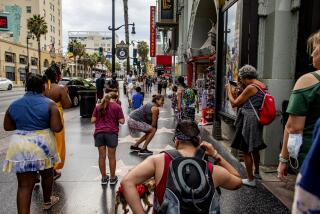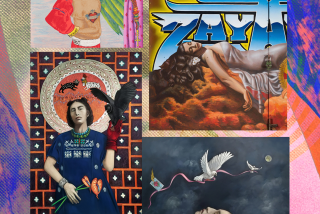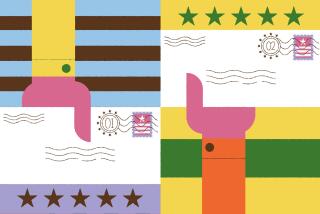American tourists invade Cuba
- Share via
HAVANA — The St. Patrick’s Day parade was a little late, but the Cuban bagpipers and the blond transvestite in green satin made up for it in spirit as they sashayed down O’Reilly Street to observe Cuba’s historic connections to Ireland. (Apparently, even Che Guevara was part Irish.)
A marching flute band played the song from “The Bridge on the River Kwai,” and a Miss Cuba Ireland was crowned.
Odd things happen when Americans come to Havana.
A video of the parade is on display at the first major exhibition of U.S. artists in Cuba in a quarter of a century, part of what organizers are calling a social experiment in connecting Cubans and Americans.
“Art is a great bridge, the way to start a conversation,” said Alberto Magnan, a New York gallery owner who is in Havana to oversee the exhibit.
Havana is crawling with Americans these days.
Young tourists stalk the rum-laced bars and plan a night out dancing. Art patrons hurry off to inspect the U.S. artists exhibition. Cuban-born Americans, loaded with gifts, visit family members in a home left behind long ago.
What travel ban?
“What are all these people doing here?” Jay Seldin, a fine-art photographer from Montclair, N.J., wondered as he sat in the lobby of a fancy hotel on the edge of Old Havana. “You don’t feel like it’s taboo.”
A new government in Washington is moving to ease decades of restrictions on travel to Cuba, in what many predict would be the first step in a far-reaching rapprochement between the two countries after nearly half a century of hostilities.
The big question on both sides of the Florida Straits is how much change in Cuba policy will President Obama risk, and how much change will Cuba’s communist rulers tolerate? Both sides have reason to move slowly.
In his campaign for president, Obama condemned U.S. policy toward Cuba as a disaster that has failed to bring about democratic change, but thus far he has made only moderate revisions. The administration has lifted travel restrictions, allowing Americans to visit family in Cuba annually, as opposed to the every-third-year visits allowed under the Bush administration.
A bipartisan group of U.S. senators last month introduced a bill that would lift most travel restrictions on all Americans.
Those motivated to come have always found ways around the rules, traveling via third countries such as Mexico, but the number of U.S. visitors could skyrocket if the journey becomes legal.
Some of the Americans in Havana during these hot, springtime days were attending the Cuban Biennale, an international art show held every three years (despite its name) and featuring the big show by U.S.-based artists, called Chelsea Visits Havana.
Magnan, its mastermind, said organizers overcame enormous bureaucracy and certain skepticism to put the display together.
“I hope that with Obama the situation eases, more museums will come here, artists . . .,” he said.
Born in Cuba, Magnan left when he was 5, a few years after the island was taken over by Fidel Castro, and has made several visits back to the island, often to promote art. He conceived the idea of the Chelsea exhibit, named for the hip Manhattan neighborhood, which involves about 30 artists.
Luly Duke, head of Fundacion Amistad, a New York-based group that promotes ties with Cuba and helped organize the exhibit, said she was surprised that Cuban officials permitted things like the parade, conceived by U.S. artist Duke Riley, and put no limits on what art was exhibited.
“To me, it’s a signal, a move towards welcoming openness,” Duke said.
There were some decidedly leftist politics on display in the exhibit, like Sarah Palin’s face on the body of a moose. And a gigantic silhouette of Obama going nose-to-nose with Castro.
“I think it’s a big yes, but no,” Osein Chala, 26, an aspiring Cuban painter, said as he observed the “Castrobama” piece, perhaps summing up the state of U.S.-Cuban affairs.
Marylin Garbey, a 41-year-old radio reporter who was also catching the art exhibit, homed in on a collection of U.S. Army patches meant to portray military abuses in Iraq, with slogans such as “Infidels rule.” She was impressed.
“We’ve always seen the U.S. as the evil kingdom, to put it like that, and this shows us there are Americans with a vision more like ours,” Garbey said. “There is more hope now, that Obama is very intelligent and there’s a lot of sympathy for him.”
Outside the cool, high-ceilinged confines of the Bellas Artes museum annex where the exhibit hangs, Cubans went about their daily lives, going to work, sitting on their stoops, playing marimba music for foreign visitors, filing past mansions -- some crumbling, some framed by scaffolding and undergoing renovation.
Although the government remains cautious, ordinary Cubans seemed hopeful that a friendlier relationship with the U.S. would be good for them.
Alejandro Tamayo, a part-time DJ with a 2-year-old child, sees broader horizons.
“If they lift the restrictions, there will be more freedom, more travel, more opportunity,” said the wiry 20-year-old with spiky hair and an earring. “Now I struggle to make 5 pesos before going home at night.”
Gisela Valdez, a trained economist selling used books in a leafy square near the Plaza de Armas, has chatted timidly with some of the American tourists who wander by.
“I think there are a lot of misconceptions we have about them, and they about us,” she said.
An estimated 50,000 Americans traveled legally to Cuba last year, down from nearly 200,000 in 2003, according to the Cuban government, when President Bush tightened the restrictions following the arrests of Cuban dissidents and journalists.
Cuban officials remain wary. They crave the hard currency travelers would bring but worry about what they see as a potentially toxic influence of too many Americans. A Tourism Ministry official bristled at a news conference when pressed on whether Cuba has the infrastructure to handle an influx.
Josefina Vidal, head of the North American section of the Cuban Foreign Ministry, said Cuba would be willing to sit down to talk with U.S. officials “tomorrow” as long as no preconditions were imposed. So far, she said, no direct overtures have been made.
“Everyone says Obama is different,” Vidal said. “We are waiting.”
And the Americans, meanwhile, keep coming.
--
More to Read
Sign up for The Wild
We’ll help you find the best places to hike, bike and run, as well as the perfect silent spots for meditation and yoga.
You may occasionally receive promotional content from the Los Angeles Times.







